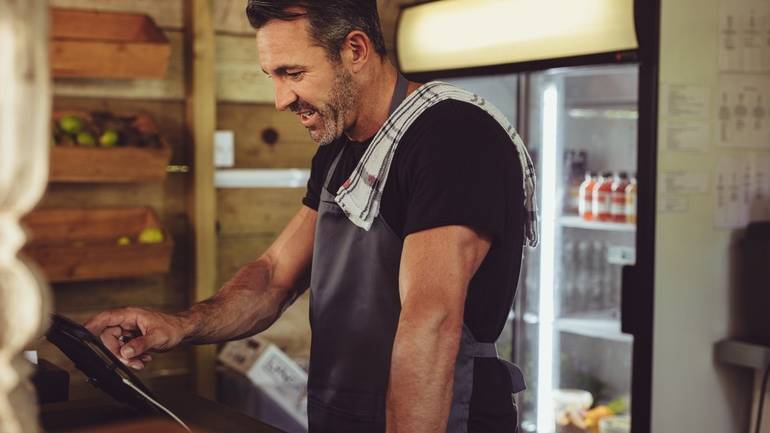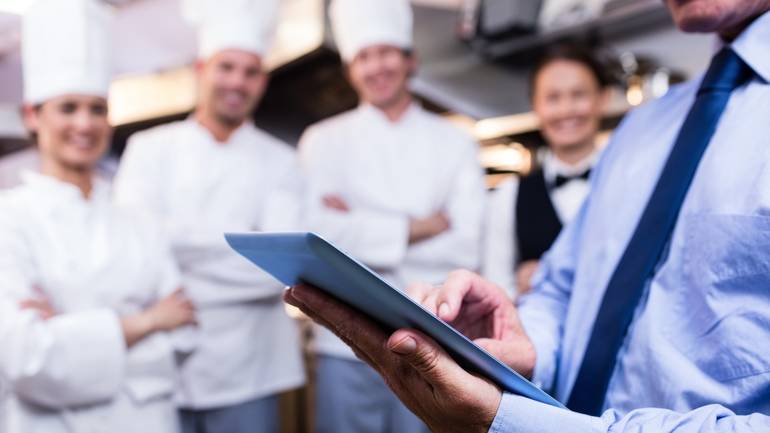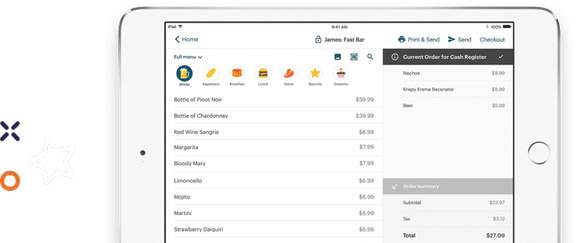| Don’t have time to read the full article? Here are the highlights |
| TouchBistro: – All-in-one POS and restaurant management system designed exclusively for restaurants – A cloud-based POS system with a built-in offline mode – Runs on iOS and Apple iPad tablets – Extensive in-house solutions, including integrated inventory management, staff scheduling, online ordering, reservations, and more – Best for single and multi-location restaurants that are growing and scaling Silverware: – Not a restaurant-specific solution (also built for hotels, resorts, golf courses, and event venues) – Hybrid system with a locally-installed connection, as well as a cloud-based app that can be accessed remotely – Runs on Windows, Android, or iOS and is compatible with a wide range of hardware – Robust, enterprise POS features, but missing essential BOH functions like inventory and labor management – Best for enterprise hospitality brands, like hotels and resorts |
If you’re in the midst of shopping for a new restaurant management system, you’ve probably wondered how TouchBistro vs Silverware POS compare.
From core features to integration partners, TouchBistro and Silverware certainly seem like similar restaurant POS systems upon first glance. However, if you dig a little bit deeper, you’ll find there are some key differences between these two popular POS systems, including the POS hardware, your payment processing options, and even the type of restaurants each product is best suited for.
Of course, understanding all of these differences requires sitting through hours of demos or scouring the web for online reviews – and no restaurateur has time for that. So to make things easier for everyone, we’ve done the work and created a comprehensive guide of our own.
In this thorough restaurant POS system comparison of TouchBistro vs Silverware, we’ll cover:
- The foundations of each system
- Core POS features
- Hardware
- Payments
- Other add-on solutions
- Integration partners
- Pricing
- Customer support
By the time you finish reading this guide, you’ll have the information you need to decide whether TouchBistro or Silverware POS is the right fit for your particular restaurant.
To learn more about other top POS systems, you can also check out our Ultimate Guide to the Best Restaurant POS Systems.
The information contained on this site is accurate as of the time of publication.

Compare the top legacy POS systems for restaurants on features, hardware, integrations, pricing, and more.
TouchBistro vs Silverware POS: An Overview
Both TouchBistro and Silverware are popular POS systems used by a wide variety of restaurants – from independent venues to nationwide chains. But while both providers cater to restaurants, their actual systems couldn’t be more different.
Below, we’ll provide an overview of TouchBistro vs Silverware, including need-to-know information about how the two systems differ and why it matters if you’re in the market for a new POS.
| TouchBistro | Silverware | |
| POS System | Cloud-based | Locally-installed with a cloud-based app |
| Operating System | iOS | Windows, Android, and iOS |
| Regional Availability | CAD, U.S., and more | CAD, U.S., and more |
| Hardware (Tablets) | iPads | iPads, Windows tablets, Android tablets, and Clover Flex terminals |
1. POS System
One of the biggest differences between TouchBistro and Silverware is the setup of the POS system itself.
Silverware’s Legacy POS System
Silverware was originally founded back in 1992, which was the era of what is known as “legacy” or “on-premise” POS systems. Silverware’s original system consisted of hardware and software located on-site in the restaurant, with all of the restaurant’s data stored on local servers. In other words, the full POS system was contained within the restaurant.
However, since the advent of cloud technology, Silverware has updated its POS system. Now, the Silverware POS is a hybrid system that supplements the legacy system’s locally installed connection with a cloud-based app. The addition of the app means that Silverware users can now access their POS data remotely with a mobile device such as a tablet.
Silverware’s efforts to modernize its POS technology has certainly made the system much more competitive with the newer cloud-based POS systems on the market. However, certain aspects of Silverware’s system still seem somewhat outdated, lagging behind some of the newer POS systems available.
For instance, Silverware POS reviews note that the system is often prone to glitches and may need to be restarted to correct certain errors. Not to mention, you can’t take full advantage of the cloud capabilities if you opt for Silverware’s most basic POS subscription plan.
TouchBistro’s Modern POS System
In contrast, TouchBistro was founded in 2010, at a time when cloud technology was revolutionizing the restaurant industry. Unlike the legacy systems of the past, TouchBistro is a modern, cloud-based POS system that runs on wireless iPad tablets and POS software that stores your restaurant’s data in the cloud via remote servers. This means that instead of all your information being contained to your restaurant, you can access your POS data from any device, at any time, as long as you have an internet connection.
Of course, not every restaurant has a reliable internet connection that can keep their POS system up and running at all times. That’s why TouchBistro also comes with a built-in offline mode to ensure that slow or unreliable internet doesn’t bring service to a standstill. In other words, there’s no risk of downtime, even if you lose your connection, because you can continue taking orders and accepting payments while offline.

2. Operating System
TouchBistro and Silverware not only differ when it comes to the POS setup, but also the operating system each POS software runs on.
Unlike most modern POS systems, Silverware runs on Windows, Android, and iOS operating systems. Some restaurateurs may favor a Windows or Android operating system, because this is what they are already familiar with. However, Windows and Android are not commonly used for restaurant POS systems because these systems come with steeper learning curves. As a result, Silverware may take longer to set up, properly configure, and learn to use. Not to mention, Windows and Android systems are also more likely to be the target of malware and are, therefore, at a higher risk of security breaches.
However, Silverware’s system is not entirely Windows or Android-based, and you can use the software on iOS. Unlike Windows or Android, iOS is generally the more popular operating system for restaurant POS systems because Apple owns both the hardware (the iPad) and the software (iOS), allowing for a seamless integration between POS software and Apple devices like iPads.
The many benefits of iOS is the reason why TouchBistro’s POS system is run exclusively on iOS. iOS is largely considered the most intuitive operating system, which makes TouchBistro a plug-and-play system that’s easy to set up and to learn – a major plus when it comes to training new staff. Additionally, iOS is a closed platform, meaning it’s less virus-prone than other operating systems.
3. Regional Availability
It’s also important to compare TouchBistro vs SIlverware on regional availability.
Silverware is a Canadian company, headquartered in Markham, Ontario. As a result, many of Silverware’s clients are located in Canada, though the company does sell its POS system to restaurant and hospitality groups in the U.S. and Europe as well.
While TouchBistro is also a Canadian company, its reach extends well beyond North America. TouchBistro is primarily designed for restaurants in Canada and the U.S. However, the system is currently used in more than 100 countries worldwide. Based on this large global footprint, TouchBistro has been able to tailor its products, services, and features to the unique needs of restaurants in each of these different regions.

Compare the top legacy POS systems for restaurants on features, hardware, integrations, pricing, and more.
Core POS Features
After a basic overview of TouchBistro vs Silverware, now it’s time to dive into the specifics, including each system’s core POS features.
| Core POS Features | TouchBistro | Silverware |
| Menu Management | ✔ | ✔ |
| Staff Management | ✔ | ✔ |
| Floor Plan Management | ✔ | ✔ |
| Tableside Ordering | ✔ | ✔ |
| Reporting | ✔ | ✔ |
| 1:1 Onboarding | ✔ | N/A |
| Customer Support | 24/7/365 | 24/7/365 |
Based on TouchBistro and Silverware POS reviews, a quick comparison reveals that both systems are equipped with the following features:
- Menu Management: Visually build, manage, and customize multiple menus and menu categories, including modifiers.
- Staff Management: Manage employees in multiple roles with personalized accounts and individually customize each employee’s permissions for operational, security, managerial, and screen access.
- Floor Plan Management: Customize your restaurant floor plan, take orders by table, move parties around, split checks, and more.
- Tableside Ordering: Mobile terminals or POS tablets can be taken tableside for faster and more accurate order taking.
- Reporting: Real-time and end-of-day reporting on everything from sales to staff performance.
Overall, both TouchBistro and Silverware offer very similar POS features. However, some of Silverware’s features are more robust, and come with a few more bells and whistles. Silverware was designed for enterprise hospitality businesses and, as a result, its POS features are designed to handle the complex demands of larger businesses with highly specific needs. For instance, Silverware can easily accommodate retirement home dining facilities, with built-in meal plan tracking capabilities. Meanwhile, hotels can benefit from a range of niche permission settings, like those for night manager, concierge, and more.
Silverware is also equipped with some advanced multi-unit management features for resorts, golf courses, and other hospitality venues. In fact, this sector makes up a major part of Silverware’s customer base.
While these robust features are a plus for many restaurants – especially large-scale hospitality brands – it’s worth noting that Silverware does have some shortcomings when it comes to its core POS features for restaurants. For instance, Silverware’s reporting functions are very limited and are a common source of frustration in Silverware POS reviews. Some of its built-in functionalities for staff management and menu management are also limited.
In contrast to Silverware, TouchBistro offers extensive POS features built specifically for restaurants. From the front of house to the back office, TouchBistro is equipped with everything restaurateurs need to run their business. And while TouchBistro may lack some of the niche functionalities that Silverware offers, TouchBistro’s more streamlined list of restaurant-specific functions not only makes the software easier to learn, but also faster to navigate during service.
Hardware
Though POS software usually gets all the attention, it’s important to take hardware into account as well. And the most important piece of hardware to consider are the tablets that serve as your POS terminals.
Silverware is a bit of an anomaly when it comes to POS hardware because of the wide range of options available to customers. Based on Silverware POS reviews, Silverware offers both on-premise and cloud-hosted deployment, so customers have the option to use Windows, Android (powered by Linux), or Apple devices. Silverware also has a partnership with Clover that allows you to use Silverware’s POS software on the Clover Flex terminals as a mobile tableside ordering and EMV payment processing solution.
For restaurateurs, having a bit more choice when it comes to hardware can be a big plus because it allows you to choose the devices you and your staff are most familiar with. However, if you choose to invest in Android or Windows devices, keep in mind that you may not be able to reuse these devices with other POS systems down the line because most modern POS systems use Apple iPads.
Unlike Silverware, TouchBistro runs on iOS, which means the only POS tablets you can use are iPads. While this does mean you’re limited to choosing between a small number of available iPad models, there are many benefits to using iPads for all of your POS terminals.
Perhaps most importantly, iPads offer a seamless user experience unmatched by other devices. iOS is very user-friendly, as are the iPads themselves. Plus, the experience is the same across all Apple devices (e.g. iPhone), so any staff already familiar with these devices will easily be able to navigate the iPad interface. And if you have a lot of front-of-house and back-of-house staff to train on your new POS system, opting for user-friendly devices like iPads can make the training process much faster.
Another major benefit of iPads is that the technology is not proprietary and can be used with several different restaurant POS systems. For example, if you decide to switch to TouchBistro from another iPad-based POS system, you can continue using any existing iPads you already have (as long as the devices are a compatible generation).

Add-On Solutions
In addition to core features, most POS providers also offer additional tools to help restaurants carry out specific functions such as taking online orders, creating loyalty programs, managing reservations, and more. Both TouchBistro and Silverware offer many different add-on solutions, including integrated payment processing.
Payments
In order to accept credit, debit, and digital payments, most restaurants work with a payment processing partner. To simplify things, most POS providers will offer POS-integrated payment processing as an add-on solution.
| Payments | TouchBistro | Silverware |
| Payments Pricing Model | Fixed rate and interchange plus pricing | Not publicly available |
For those interested in an in-house payment processing solution, Silverware offers a connected solution called Silverware Pay. This solution integrates directly into the Silverware POS platform, which helps to reduce errors, streamline workflows, and save staff time. Silverware Pay is also designed to handle payments at scale, making it a good option for hotels, resorts, or facilities that process a larger volume of transactions.
Even if you do not choose to use Silverware Pay, you can still use the Silverware POS system. However, it’s important to keep in mind that if you choose to use an unintegrated payments solution, you’ll have to carry out all credit card transactions separately and enter the amounts from each transaction manually into your Silverware POS system. This can be a problem because manually entering each transaction is both time-consuming and carries a high risk of error.
However, it’s important to keep in mind that if you choose to use an unintegrated payments solution, you’ll have to carry out all credit card transactions separately and enter the amounts from each transaction manually into your Silverware POS system. This can be a problem because manually entering each transaction is both time-consuming and carries a high risk of error.
TouchBistro also offers its own in-house payment processing solution, TouchBistro Payments. Backed by a trusted financial institution, TouchBistro Payments delivers best-in-class payment processing technology, advanced security, and the support of dedicated payments experts.
Another major benefit of TouchBistro payments is the direct integration with the POS, which is a huge plus for multi-location operators processing hundreds to thousands of payments each day. Thanks to this integrated workflow, the POS speaks directly to the payment terminals, allowing for a seamless flow of data and eliminating the need for manual entry. This direct integration reduces the risk of order errors (and subsequent chargebacks), while also ensuring a quick and easy payment process for customers.
Other Add-On Solutions
In addition to integrated payments, most POS providers offer additional add-on features that can help restaurateurs grow or pivot their business. This can include adding everything from adding a loyalty program to drive repeat business, to adding online ordering to customers’ shifting preferences.
| Add-On Solutions | TouchBistro | Silverware |
| Integrated Payments | ✔ | ✔ |
| Inventory | ✔ | ✘ |
| Labor Management and Staff Scheduling | ✔ | ✘ |
| Online Ordering | ✔ | ✔ |
| Integrated Delivery | ✔ | ✘ |
| Reservations | ✔ | ✘ |
| Gift Cards | ✔ | ✔ |
| Loyalty and Customer Relationship Management | ✔ | ✔ |
| Marketing | ✔ | ✔ (part of the loyalty program) |
| Back Office Management | ✔ | ✘ |
| Self-Serve Kiosks | ✘ | ✔ |
| Kitchen Display System | ✔ | ✔ |
| Customer Facing Display | ✔ | ✔ |
| Digital Menu Board | ✘ | ✘ |
When you compare TouchBistro vs Silverware head-to-head, it’s clear that both providers offer many of the same add-on solutions, including:
- Payments: Integrated payment processing services.
- Inventory Management: Robust inventory and recipe management software that helps operators keep track of what’s on hand, forecast for the future, and more.
- Labor Management & Staff Scheduling: Comprehensive labor management software that helps operators manage their teams and quickly create schedules.
- Online Ordering: A POS-integrated ordering system that gives customers the ability to place orders for takeout or pickup directly from a restaurant’s website and other online channels.
- Gift Cards: Branded physical gift cards with multi-location reconciliation.
- Loyalty, CRM, and Marketing: Customer relationship management tools, restaurant reward programs, and marketing promotion capabilities.
- Kitchen Display System (KDS): A digital system for restaurant kitchens that displays orders for the back-of-house staff.
As a product designed for enterprise, it comes as no surprise Silverware offers a wide range of add-on solutions. And many of these add-on solutions are very robust, making them ideal for larger restaurant brands. For instance, Silverware offers a simple and intuitive self-service kiosk product that can help major QSR chains save time and money on labor costs by empowering guests to place and pay for their orders independently.
While Silverware offers some unique add-ons, it’s actually missing quite a few add-on solutions that are essential for restaurants. Solutions that TouchBistro does offer.
For instance, TouchBistro offers in-house add-on solutions for inventory management, labor management, back office management, and reservations – none of which are products available through Silverware directly. Inventory and labor management are especially important for any restaurant to have because these solutions can help keep food and labor costs in check – two of a restaurant’s biggest expenses. Not to mention, back office software is necessary for budgeting, accounting, and managing important invoices.

Compare the top legacy POS systems for restaurants on features, hardware, integrations, pricing, and more.
Integration Partners
Of course, no one POS system can do it all, which is why both TouchBistro and Silverware POS offer integrations with major third-party partners. These partner apps help extend the capabilities of your POS with solutions for payroll, labor management, accounting, online ordering, and much more.
| Integration Partners | TouchBistro | Silverware |
| Online Ordering and Delivery | ✔ | ✔ |
| Reservations | ✘ (in-house solution) | ✔ |
| Customer Relationship Management and Loyalty | ✘ (in-house solution) | ✔ |
| Staff Management, HR, and Payroll | ✔ | ✔ |
| Inventory Management | ✔ | ✔ |
| Accounting | ✔ | ✔ |
| Reporting and Analytics | ✔ | ✔ |
A quick glance of TouchBistro and Silver’s third-party partners shows that both providers offer integrations for the following types of services:
- Online Ordering and Delivery Marketplaces: Includes online ordering aggregators that sync multiple different third-party ordering apps with your POS system.
- Staff Management, HR, and Payroll: Employee scheduling and labor management tools, as well as payroll providers.
- Inventory Management: Advanced inventory management tools for both restaurants and bars.
- Accounting: Cloud accounting tools and middleware software.
- Reporting and Analytics: Advanced reporting tools that help to aggregate and simplify business data.
While both TouchBistro and Silverware each offer their fair share of integrations, Silverware comes out on top when it comes to the sheer number of third-party integrations available. This is largely because Silverware is designed as an enterprise solution for restaurants and hospitality businesses, so it needs to be able to support a wide variety of niche functions. For instance, Silverware offers integrations with a number of property management systems (PMS) that enable hotels to manage front-office capabilities, such as booking reservations, checking guests in and out, room assignments, managing room rates, and billing. Silverware also supports integrations for important functions, such as security and advanced reporting.
While the ability to choose from dozens of different third-party integrations can help restaurants significantly extend the capabilities of their POS system, all this comes at a cost. While most POS providers include integrations at no cost as part of their systems maintenance fees, Silverware charges a $25 per month integration fee.
Unlike Silverware, TouchBistro offers a much smaller, more curated list of integration partners. This is because TouchBistro already has its own in-house solutions for just about everything a restaurant might need, including online ordering, reservations, loyalty, and more. For many restaurants, these kinds of in-house solutions are preferable to third-party integrations because there is less risk of errors and data loss. Not to mention, in-house solutions make getting a hold of customer support far easier because the only number you need to call is your POS provider.
And for the niche functions that TouchBistro doesn’t have in-house solutions for, TouchBistro does offer a curated list of best-in-class third-party solutions. This list includes partners like Deliverect for online ordering aggregation, Push Operations for payroll, and QuickBooks for accounting

Pricing
No review of TouchBistro vs Silverware would be complete without comparing the cost of the two systems.
| Pricing | TouchBistro | Silverware |
| Software Pricing | Starting at $69 USD / month for a single license | Starting at $99 USD / month for a single license (+$35 / month for each additional license) |
The Silverware POS software starts at $99 per month for a single license. Additional licenses, add-on solutions, integrations, and integrations payments will all cost you extra, so it’s best to contact the company directly to better understand your total monthly costs. Additionally, you’ll also have to factor in the cost of purchasing any proprietary hardware.
For the most part, Silverware’s monthly software fees are in line with other POS providers on the market. However, its cheapest package lacks many important features, such as real-time cloud reporting, real-time cloud backup, and real-time system failover.
But, it’s important to keep in mind that while Silverware’s prices may seem reasonable, there are some additional fees that may come when you choose a legacy system. For instance, if you’re using any hardware that is installed on-site, you’ll have to pay to have that hardware upgraded or replaced if it ever becomes outdated. You may also need to pay for a technician to come fix or upgrade your on-site system if any problems arise. Not to mention, you’ll also have to factor in the cost of each integration you plan to use with your Silverware POS.
In contrast, TouchBistro’s software pricing starts at $69 per month for a single license. Not only is this monthly fee lower than Silverware’s starting package, but you also get a whole lot more. In addition to 24/7/365 support, all of TouchBistro’s packages include the full set of core POS features, free integrations, and cloud-based reporting and analytics. This means you get to enjoy all the benefits of the cloud, no matter how many (or how few) TouchBistro licenses you have.
Customer Support
Finally, and perhaps most importantly, we’ve combed through online reviews to see how TouchBistro vs Silverware compare when it comes to customer support.
All of Silverware’s software subscriptions come with 24/7/365 support, which is a huge plus for any restaurateur. Customers can access support by calling the phone number for the closest regional office, by email, or by filling out a form on the company’s website.
Beyond phone and email support, Silverware also has a full page of video tutorials online. However, it’s important to note that most of these videos are intended for training purposes and not for working through technical hardware issues or software problems. In fact, Silverware has a noticeable absence of technical support information available online, which means you have to phone or email the company each time an issue occurs, rather than attempt to troubleshoot it on your own. And based on Silverware POS reviews, the quality of support you’ll receive may not always be consistent.
On the other hand, TouchBistro offers a wide range of available support options. For any issues with TouchBistro’s hardware, software, or integrated payments, all customers have access to 24/7 phone or email support, 365 days of the year. This means you can get answers to any question, at any time. And unlike Silverware, TouchBistro also boasts an extensive online resource library, complete with step-by-step technical guides and videos that restaurateurs can use to quickly troubleshoot and solve many issues on their own.

Compare the top legacy POS systems for restaurants on features, hardware, integrations, pricing, and more.
TouchBistro vs Silverware POS: The Bottom Line
After comparing TouchBistro vs Silverware on all of the most important features, it’s clear that both POS systems are a good option for a wide variety of restaurants. Both systems are feature-rich, offer extensive customer support hours, and are reasonably priced.
While TouchBistro and Silverware are comparable, it’s clear that the Silverware POS is better suited to enterprise-level hospitality businesses, such as hotels and resorts. Silverware not only has extensive POS features designed to support and manage multiple locations, but it also offers extensive add-ons and integrations with the kind of solutions that hotel chains require and restaurants located within a resort may require.
While Silverware is a great fit for enterprise, TouchBistro is the better all-around solution for growing single and multi-location restaurants based on the following reasons:
1. Modern Technology
With a myriad of challenges facing the restaurant industry, it’s clear that technology is more important than ever in helping operators navigate a changing landscape. And with that in mind, you want to ensure that the POS system you’re using is equipped with the most cutting-edge hardware and software. As a company founded during the advent of cloud technology, TouchBistro has always been a leader when it comes to restaurant technology. When you use a TouchBistro system, you get all the advantages of a system that’s fast, secure, and mobile-first.
In contrast, Silverware has been in the POS space for nearly two decades. And while the company has upgraded its system by adding cloud capabilities to its POS setup, the company still relies on some older technology and hardware that is not very user-friendly. For some restaurants, this particular setup may make training new staff more challenging and ultimately hinder long-term growth.
2. User-Friendly System and Quick Setup
With so many different POS systems available, you want to make sure you choose a system that you and your staff can confidently learn and use on a daily basis. TouchBistro runs on an iOS operating system and uses Apple hardware, which is widely considered the most intuitive and user-friendly option when it comes to POS software and hardware. Even if your staff is not very familiar with Apple devices, the plug-and-play nature of the TouchBistro system means that just about anyone can learn to use it without extensive training.
Unlike TouchBistro, Silverware runs on Windows, Android (Linux), and iOS operating systems. Windows and Linux come with steeper learning curves than iOS and are not widely considered to be a very intuitive system to learn. As a result, Silverware may not be the most user-friendly system for new staff to learn, and may take more time to initially set up and properly configure.
3. Restaurant-Focused
Finally, TouchBistro was originally designed by restaurant industry professionals with the goal of making the process of running a restaurant easier and more profitable. This wealth of expertise and first-hand industry knowledge is the reason TouchBistro’s core POS is equipped with features that are robust enough to support a wide variety of functions, but also intuitive enough for all front of house and back of house staff to use.
This ongoing dedication to creating restaurant-specific solutions means that all of TouchBistro’s long-term research and development is devoted to helping restaurants adapt to a changing industry landscape.
In contrast, companies like Silverware create products for a variety of industries, including hotels, resorts, golf courses, and other hospitality businesses. This split focus means there may be less emphasis on continuously improving features and add-on solutions built specifically for restaurateurs. Over time, this may mean that you may end up relying on third-party integrations (instead of in-house solutions) for some very essential functions.
No restaurant POS system is a one-size-fits-all solution, which is why a little research can go a long way in helping you find the right solution for your business. With this head-to-head comparison of TouchBistro vs Silverware POS, you now have the information you need to figure out which of these two popular POS systems will work for your restaurant.






